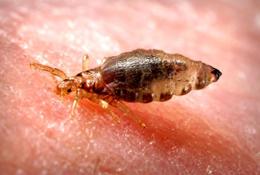-
rôle du poux dans l'histoire humaine
Sequencing Napoleon's nemesis
Body-louse genome offers a glimpse into the genetic legacy of life as a permanent parasite.
 Body lice have played a key role in human history.James Gathany / CDC
Body lice have played a key role in human history.James Gathany / CDCThey are our some of our nearest, but not dearest, neighbours. They have clung to us for most of the roughly 70,000 years since humans first donned clothes. Our wardrobes gave them shelter — and in return, they gave us typhus and trench fever.
The body louse has shaped human history. It has been blamed for weakening Napoleon's soldiers as they floundered in Russia, and even for contributing to the spread of bubonic plague. Now, in a paper published this week in the Proceedings of the National Academy of Sciences, its genetic secrets have been laid bare as researchers report the genome sequence of mankind's pesky hitchhiker, Pediculus humanus humanus1.
The honour thrusts the body louse into the company of a select few entomological nasties with sequenced genomes, including the parasitic wasp (Nasonia; see 'Parasitic wasps' DNA laid bare') and two species of mosquito (Aedes aegypti and Anopheles gambiae; see 'Mosquito genome leaves researchers itching for more').
Other insects have also had their genomes sequenced — the famous fruitfly Drosophila melanogaster and the industrious honeybee Apis mellifera among others — but the body louse is the only member of this elite club that is 'hemimetabolous', meaning that it does not undergo complete metamorphosis.
Juvenile body-louse nymphs look like miniature adults, and this is believed to reflect a more primitive state in arthropod evolution, says Dale Clayton, an evolutionary parasitologist at the University of Utah, Salt Lake City, who was not involved with the study.
"This genome is a gold mine of genes to use in constructing the evolutionary relationship among thousands of other insect groups," he says.
Bloody diet
The body louse is called a 'permanent' parasite because it relies on its host at every stage of its life cycle. From the moment a body louse emerges from its egg, buried in a seam of clothing, it dines on nothing but human blood. "That's a really poor diet," notes Clayton, "There's a lot of important nutrition missing from blood."
The new genomic analysis has revealed a source of at least one of those missing nutrients: the sequence of a bacterium living in the body louse, Candidatus Riesia pediculicola, turned up several genes involved in the synthesis of vitamin B5. Without that bacterium, the body louse is doomed, says Barry Pittendrigh, an entomologist at the University of Illinois at Urbana-Champaign and a member of the genome sequencing team.
In fact, as may be expected from its highly dependent lifestyle, the body louse has a streamlined genome that lacks many genes associated with sensing and responding to the environment, particularly those associated with smell and taste.
Body lice also have fewer genes that detoxify risky compounds. This feature is of particular note to John Clark, a neurotoxicologist at the University of Massachusetts, Amherst, who studies the growing problem of pesticide resistance in head lice (Pediculus humanus capitis).
The dearth of detoxifying enzymes in body lice means less work for his lab as they sift through and catalogue each enzyme according to its substrates and activities, he says. For example, compared with Drosophila, body lice have only a third as many members of the cytochrome p450 class of such enzymes.
Head lice, which can run rampant among children, are much more common than body lice, which are found primarily on those who may lack access to regular showers and changes of clothing, such as the homeless. But although the two are closely related, head lice do not transmit the bacterial diseases carried by body lice, notes Clayton, a mystery that he hopes will be addressed by future studies now that the genome is in hand.
"Body lice are rare, but when they're around they're really dangerous because of this vectoring capability," he says. "If suddenly one of these bacterial agents mutates in a way that allows it to be vectored by head lice, then you've got an enormous problem."
Kirkness, E. F. et al. Proc. Natl Acad. Sci. USA doi:10.1073/pnas.1003379107 (2010).
http://www.nature.com/news/2010/100621/full/news.2010.308.html
-
Commentaires
Mon petit cahier de sciences naturelles

